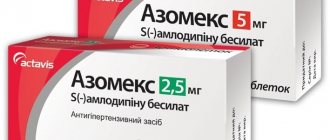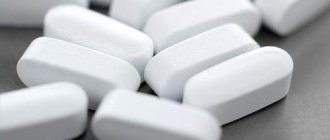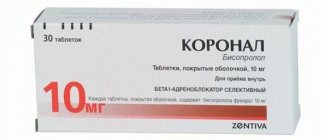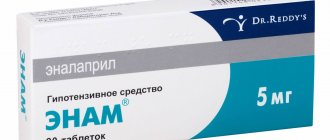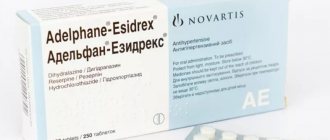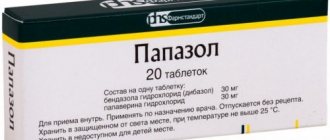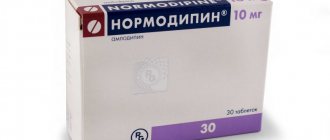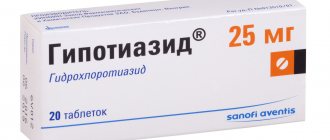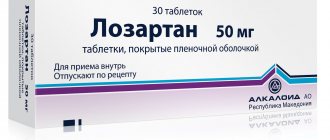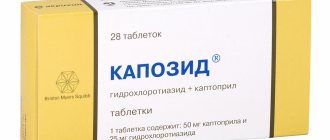High blood pressure requires medical attention. It is necessary to visit a cardiologist who, after a comprehensive examination, will prescribe drug treatment. Blood pressure medications are prescribed according to indications. The goal in the treatment of hypertension is to normalize blood pressure and eliminate the root cause of the disease. Felodip tablets help with blood pressure, block calcium channels, and have an anti-ischemic effect. The antihypertensive drug can only be taken as prescribed by a doctor.
Instructions for use of Felodip Felodipine
The tablets are taken without violating their integrity.
They should be swallowed with water (half a glass). The dose of the drug for the appointment is determined by a specialist. To take Felodip tablets, choose the morning time. This can be done after a small breakfast or before meals.
- For angina pectoris, it is recommended to adhere to the following rules. Treatment begins with a single dose of 5 mg of the drug per day, unless otherwise directed by the doctor. In 24 hours, the amount of active substance taken should not exceed 20 mg. If necessary, a single dose can be increased to 10 mg. In case of disturbances in the functioning of the liver, the single dose is reduced to 2.5 mg. In the case of kidney disease, no dose adjustment is made.
- For high blood pressure, it is recommended to take the drug as follows. For the initial dose in old age, take 2.5 mg; at a younger age, you can start with a single dose of 5 mg. The drug is taken once a day. The amount of the drug taken can be changed by the attending physician; you should consult with him before starting the course. The maintenance dose is usually 5–10 mg per 24 hours. Instead of increasing the single dose, you can add another drug with a similar effect.
Read below about contraindications to taking felodip (felodipine).
Felodip oral tablets
Instructions for medical use of the drug
Description of pharmacological action
Felodip belongs to the blockers of “slow” calcium channels of the dihydropyridine series. Has a hypotensive, antianginal effect. Reduces blood pressure by reducing peripheral vascular resistance. Has a dose-dependent anti-ischemic effect. Reduces the size of myocardial infarction and protects against complications of reperfusion. It has virtually no negative inotropic effect and has minimal effect on the conduction system of the heart.
Indications for use
- arterial hypertension; - stable angina (including Prinzmetal's angina).
Release form
tablets, film-coated, extended-release 2.5 mg; blister 10, cardboard pack 10; tablets, film-coated, extended-release 5 mg; blister 10, cardboard pack 10; tablets, film-coated, extended-release 10 mg; blister 10, cardboard pack 10; tablets, film-coated, extended-release 5 mg; blister 10, cardboard pack 3; tablets, film-coated, extended-release 2.5 mg; blister 10, cardboard pack 3; tablets, film-coated, extended-release 5 mg; blister 10, cardboard pack 3; tablets, film-coated, extended-release 10 mg; blister 10, cardboard pack 3; tablets, film-coated, extended-release 5 mg; blister 10, cardboard pack 3; Warehouse Long-acting tablets, coated 1 tablet. active speech: felodipine 2.5 mg additional speech: lactose monohydrate - 25.2 mg; MCC (type Avicel PH101) - 51.75 mg; hypromelose (type Methocel E50LV) - 110 mg; povidone (type K-25) - 7.35 mg; Propylgalate - 0.067 mg; MCC (type Emcocel 90M) - 8 mg; magnesium stearate - 0.833 mg; anhydrous silica - 1.3 mg shell: hypromelose (Pharmacot 606 type) - 6.149 mg; Zaliza zhovtium oxide (E172) - 0.192 mg; titanium dioxide (E171) - 0.954 mg; talc - 0.93 mg; propylene glycol - 1.074 mg active substance: felodipine 5 mg additional substances: lactose monohydrate - 23.95 mg; MCC (type Avicel PH101) - 50.5 mg; hypromelose (type Methocel E50LV) - 110 mg; povidone (type K-25) - 7.35 mg; propylgalate - 0.067 mg; MCC (type Emcocel 90M) - 8 mg; magnesium stearate - 0.833 mg; anhydrous silica - 1.3 mg shell: hypromelose (type Pharmacoat 606) - 6.666 mg; Zaliza zhovtium oxide (E172) - 0.007 mg; Zaliza chervonium oxide - 0.019 mg; titanium dioxide (E171) - 0.435 mg; talc - 1.008 mg; propylene glycol - 1.165 mg active substance: amlodipine 10 mg additional substances: lactose monohydrate - 21.45 mg; MCC (type Avicel PH101) - 48 mg; hypromelose (type Methocel E50LV) - 110 mg; povidone (type K-25) - 7.35 mg; Propylgalate - 0.067 mg; MCC (type Emcocel 90M) - 8 mg; magnesium stearate - 0.833 mg; anhydrous silica - 1.3 mg shell: hypromelose (Pharmacot 606 type) - 6.149 mg; Zaliza zhovtium oxide (E172) - 0.044 mg; zaliza chervonium oxide - 0.081 mg; titanium dioxide (E171) - 0.467 mg; talc - 0.992 mg; propylene glycol - 1.144 mg in a blister with aluminum foil-PVC / polyvinylidene chloride / PE 10 pcs.; There are 3 or 10 blisters in a cardboard package.
Pharmacodynamics
Felodip is related to blockers of “high” calcium channels in the dihydropyridine series. It has a hypotensive, antianginal action. Reduces AT due to changes in the peripheral vessel support. Volodya has a dose-dependent anti-ischemic effect. Reduces the size of myocardial infarction and protects against worsening reperfusion. It has virtually no negative effect and has minimal impact on the cardiac conduction system.
Pharmacokinetics
The incubation and distribution of the enhanced strength of felodipine from film-opened tablets is carried out until the active phase of the infusion of the drug and ensures a uniform concentration of felodipine in the plasma for 24 years. Felodipine may be fully absorbed into the SCT. The bioavailability of the drug does not remain at the dose within the therapeutic interval and becomes approximately 15%. 99% of felodipine binds to blood plasma proteins, first to albumins. Metabolism and excretion Felodipine is primarily metabolized in the liver and all its metabolites are inactive. T1/2 of felodipine is 25 years old. In case of trivial stagnation of cumulation, felodipine is not indicated. Pharmacokinetics in special groups of patients In summer illnesses and in episodes of impaired liver function, the concentration of felodipine in plasma is lower in young patients. The pharmacokinetic properties of felodipine do not change in patients with impaired neuronal function, incl. and during hemodialysis. Approximately 70% of the administered dose is excreted in the urine, and the rest is excreted in the feces in the form of metabolites. In an unchanged patient, less than 0.5% of the administered dose is excreted. Felodipine penetrates the blood-brain barrier, into the placenta and is excreted in breast milk.
Use during pregnancy
Felodip is contraindicated before pregnancy during pregnancy and during lactation (breastfeeding).
Use for renal impairment
In patients with impaired function, the pharmacokinetics of the drug do not change significantly. Use caution when using the drug in case of nitric deficiency.
Other special occasions at reception
For patients with impaired liver function, the dose should be 2.5 mg/day. In patients with severely impaired liver function, the dose of the drug should be changed. Use the drug with caution in case of liver failure.
Contraindications for use
— increased sensitivity to felodipine and other similar dihydropyridines; - unstable angina; - acute myocardial infarction within one month after myocardial infarction; — cardiogenic shock; — clinically significant aortic stenosis; — gestation and lactation period; — heart failure in the stage of decompensation; - severe arterial hypotension; — century to 18 years (efficiency and safety have not been established). With caution: pechenkova and / or nikovka deficiency.
Side effects
Just like with other calcium channel blockers, the drug can cause headaches, headaches, heart problems, confusion and fatigue. These reactions are reversible and most often occur on the cob or with a larger dose of the drug. Also, depending on the dose, peripheral swellings may appear, as a result of precapillary vasodilation. In patients with inflammation, it is clear or periodontitis may result in a slight swelling. This can cause damage to the proper hygiene of the empty mouth. In several episodes: On the side of the fur coats: rarely - kropivyanka and sverbizh. In single episodes there are photosensitivity reactions. On the side of the musculoskeletal system: in single episodes - arthralgia, myalgia. On the side of the central and peripheral nervous systems: headache, confusion. In rare cases - paresthesia. On the side of the grass tract: rarely - tediousness, hyperplasia is clear; increased activity of liver enzymes. On the side of the CCC: rarely - tachycardia, heart palpitations, peripheral swellings. Others: rarely - fatigue, in isolated cases - hypersensitivity reactions, such as angioedema.
Directions for use and doses
In the middle. It is best to take the drug immediately, before eating or after a light meal. The coated tablets can be crushed, divided or trimmed. Arterial hypertension Adults (including older adults). Dosing is determined individually. Therapy begins with a dose of 5 mg once a day. If necessary, dosage can be increased; Set the supporting dose to 5-10 mg 1 time per day. To determine an individual dose, it is best to take tablets instead of felodipine 2.5 mg. In summer people or those who are ill with impaired liver function, a dose of 2.5 mg once a day is recommended. Stable angina pectoris. Dosing is determined individually. Treatment begins with a dose of 5 mg 1 time per day; if necessary, the dose can be increased to 10 mg 1 time per day. The maximum dosage is 20 mg once a day. The drug Felodip can be used in combination with beta-blockers, ACE inhibitors or diuretics. Combination therapy is superior to the antihypertensive effect of the drug. It is necessary to beware of the development of arterial hypotension. In patients with severely impaired liver function, the therapeutic dose must be reduced. In patients with impaired function, the pharmacokinetics of the drug does not change significantly.
Overdose
Symptoms: pronounced arterial hypotension, bradycardia. Treatment: carry out symptomatic therapy. When arterial hypotension develops, place the patient in a horizontal position with legs raised. For bradycardia - intravenous administration of atropine at a dose of 0.5-1 mg. If necessary, to increase the plasma concentration, infusions of glucose, sodium chloride or dextran should be performed. Drugs with an important effect on α-adrenergic receptors are prescribed when other treatments are ineffective.
Interactions with other drugs
Amlodipine increases the concentration of digoxin in the blood plasma, but no change in dosage of felodipine is required. Inhibitors of cytochrome P450 (for example, cimetidine, erythromycin, itraconazole, ketoconazole) increase the metabolism of felodipine in the liver, increasing the concentration of the drug in the blood plasma. Enzyme inducers (phenytoin, carbamazepine, rifampicin, barbiturates) reduce the plasma concentration of felodipine. NSAIDs do not reduce the hypotensive effect of felodipine. The high degree of binding of felodipine to proteins does not affect the binding of the free fraction of other drugs (for example, warfarin). Do not mix Felodipine with grapefruit juice because it contains flavonoids that increase the bioavailability of Felodipine. Beta-blockers, verapamil, tricyclic antidepressants and diuretics enhance the hypotensive effect of Felodip.
Special instructions for use
The drug Felodip, as well as other vasodilators, can in rare cases cause significant arterial hypotension, which can lead to the development of myocardial ischemia in a number of sick patients. At this time, there is no data on the effectiveness of the drug for secondary prevention of myocardial infarction. Phelodip is effective and well tolerated by patients regardless of their condition and age, as well as by patients with concomitant illnesses, such as bronchial asthma and other illnesses of the lungs, impaired nic function, blood Diabetes, gout, hyperlipidaemia, Raynaud's syndrome, and also after leg transplantation. Felodip does not affect blood glucose concentration or lipid profile. Pour into the building before water vehicles and robots: patients who are weak, confused during the treatment with felodipine, should be able to handle water using vehicles and robots. increased respect and concentration.
Storage conditions
Protected in a bright place, at a temperature of 10-25 ° C.
Best before date
48 months
ATX classification:
C Cardiovascular system
C08 Calcium channel blockers
C08C Selective calcium channel blockers with a predominant effect on blood vessels
C08CA Dihydropyridine derivatives
C08CA02 Felodipine
Overdose
If you follow the dosage and regimen prescribed by your doctor, the likelihood of dosage is minimal. Negative consequences appear only when taking tablets in excess of the prescribed norm. First of all, you should be wary of a sudden drop in blood pressure, which can lead to a worsening of the condition.
If an overdose is established, the patient's stomach is washed and activated charcoal is prescribed. It is also necessary to carefully monitor the functioning of the heart and lungs.
The person is placed on his back, his legs are raised slightly, and to eliminate unwanted symptoms, saline, glucose, and also drugs that prevent a further decrease in blood pressure, for example, Dopoman or Mezaton, are administered.
Interaction with other medications:
- The effect of Felodipine is enhanced by other substances whose action is aimed at lowering blood pressure. Thus, when drawing up a treatment regimen that contains several drugs with the same effect, their effect is summed up.
- Nonsteroidal anti-inflammatory drugs do not affect the effectiveness of Felodipine.
- Inhibitors increase the concentration of the active substance felodipine, so as not to cause an overdose and side effects; the doctor reduces the dosage of drugs if there is a need for their simultaneous use.
- Inducers of microsomal enzymes reduce the amount of felodipine; to achieve stable positive dynamics, the dosage of felodipine is adjusted upward.
Pharmacokinetics
The described agent is a calcium channel blocker. Its active ingredient is felodipine.
Due to this, the concentration of calcium in the blood vessels decreases. This leads to their relaxation and a decrease in readings on the tonometer.
At the same time, the drug does not have any effect on smooth vascular muscles and helps reduce the severity of peripheral vascular resistance.
The anti-ischemic effect of the drug is manifested due to its ability to improve oxygen saturation of the heart, accelerate blood circulation, and also reduce the load on the myocardium and reduce its need for oxygen.
In addition, Felodipine has a mild diuretic effect. This occurs by blocking sodium reabsorption. At the same time, the amount of potassium and albumin excreted in the urine does not change. If renal function is impaired, an increased intensity of glomerular filtration may develop.
The drug does not affect the level of glucose and cholesterol in the blood, so this drug can be used by diabetics.
Felodipine begins to have a hypotensive effect approximately two hours after its administration. This effect continues throughout the day. At the same time, the higher its concentration in the blood, the more the pressure decreases.
The active substance is quickly and completely absorbed from the stomach into the blood. However, its bioavailability during the first passage through the liver is low and amounts to only 20%.
Approximately 3-5 hours after consuming the drug, its highest concentration is observed in the plasma. If you take the medicine regularly, this time is reduced.
The half-life of the drug can range from 11 to 16 hours. Creatinine clearance is 200 ml per minute.
When the drug is processed by the liver, 6 active metabolites are released. Moreover, their effect is only 23% of the effectiveness of the active substance in unchanged form.
Felodipine can cross the placental barrier and passes into breast milk. When taking the drug regularly, there is no cumulative effect.
Most of the active substance is excreted through the urine as metabolites. Felodipine is also found in smaller quantities in feces and urine in an unconverted form.
It is worth noting that in case of liver diseases, as well as in patients over 70 years of age, an increase in the concentration of the drug in the blood is observed. However, if the functioning of the kidneys is impaired, such an effect is not detected.
Binding to plasma proteins, mainly albumin, is about 99%. Penetrates through the BBB and placental barrier, excreted in breast milk. With long-term use, felodipine does not accumulate.
Felodipine is almost completely metabolized in the liver to form inactive metabolites.
T1/2 of felodipine is 25 hours. About 70% of the dose taken is excreted in the form of metabolites in the urine, the rest is excreted in the feces in the form of metabolites. Less than 0.5% of the dose is excreted unchanged in the urine.
Pharmacokinetics in special clinical situations
In elderly people and in patients with impaired liver function, the concentration of felodipine in the blood plasma is higher than in young patients.
The pharmacokinetic parameters of felodipine do not change in patients with impaired renal function, incl. and during hemodialysis.
Rules for using Felodipine
It is very important when taking the drug to follow all the basic rules and take into account important nuances. In this case, it will be most effective and will not lead to unpleasant symptoms.
Nuances of using the product:
- When taking the tablet, do not break it or crush it. This is due to the fact that it is the shell that prevents too intense absorption of the active substance of the drug into the circulatory system. Therefore, it is necessary to buy tablets in the right dosage.
- When taking this product, you should not drink grapefruit juice. It will reduce the effectiveness of Felodipine and increase the likelihood of negative effects.
- Also, you should not use infusions and decoctions of St. John's wort. They may increase the severity of the antihypertensive effect of the drug and increase the risk of side effects.
- This drug is not used to prevent a recurrent heart attack, since its effectiveness in this case has not been proven.
- Felodipine does not directly affect the ability to drive complex machinery and vehicles. However, its side effects may lead to decreased concentration. Therefore, you should not drive a car when you start taking the drug.
- Animal tests have shown that the drug does not have mutagenic or carcinogenic activity. However, research has revealed its teratogenic and embryotoxic effects.
- You need to take the drug at the same time. In this case it will be most effective.
- When athletes take this medication on the eve of competitions, false positive doping test results are not detected.
Reviews about Felodip
Since the drug is quite expensive, it is used less frequently than other slow calcium channel blockers (Nifedipine, Amlodipine and Lercanidipine).
However, those patients who prefer this particular drug leave mostly positive reviews about Felodip. It is effective in the treatment of hypertension and is well tolerated by patients.
Patients with angina pectoris noted that with long-term therapy, the severity and frequency of anginal pain decreases and their well-being significantly improves.
Compatibility of Felodipine with other substances
Felodipine should be carefully included in combination drug therapy. After all, this remedy, when combined with certain substances, can give distorted effects. Therefore, a doctor must select medications for treatment.
| Drug groups | Effects that their combinations with Felodipine can produce |
| Digoxin | Increasing the dosage of Digoxin in blood plasma. However, in this case, a revision of the dosage of the drugs is not required. |
| Cytochrome blockers | In this case, the concentration of Felodipine in the body increases. This occurs due to a decrease in the intensity of hepatic metabolism of the drug. Thanks to this, the effectiveness of the product increases. |
| Microsomal enzyme inducers | Reduced concentration of the active substance Felodipine in the body. This reduces its effectiveness. |
| Non-steroidal anti-inflammatory drugs | Unlike many antihypertensive drugs, NSAIDs do not have any effect on the effectiveness of Felodipine. |
| Beta blockers | Increased hypotensive effect of the drug. |
| Diuretics | Increasing the ability of the drug to reduce pressure. When taking potassium-sparing diuretics, the likelihood of developing hyperkalemia increases. |
| Tricyclic antidepressants | Acute hypotension may develop. The likelihood of acute side effects increases. |
| Verapamil | The antihypertensive ability of the drug increases. |
| Inducers of macrosomal oxidation | Significantly reduce the concentration of the drug in the blood. The antihypertensive ability of the drug decreases. |
| Tacrolimus | Increase of tacrolimus in the body. When combining such drugs, a review of their dosage is necessary. |
| Cyclospirin | Significantly increases the concentration of felodonin in the body. Its hypotensive ability also increases. |
Drug interactions
Some medications increase the concentration of Felodip in the blood and slow down the release of metabolites:
- Intraconazole;
- Ketoconazole;
- Cimetidine;
- Erythromycin.
When Felodip is used for blood pressure simultaneously with Digoxin, the blood level of the latter increases. No dose adjustment is required for Felodip tablets.
Some medications reduce the level of felodipine in the blood:
- barbituric acid derivatives;
- Carbamazepine;
- Rifampicin;
- Phenytoin.
Nonsteroidal anti-inflammatory drugs do not affect the antihypertensive effect of Felodip.
The antihypertensive effect of Felodip may be increased due to the simultaneous use of other antihypertensive drugs:
- diuretics;
- beta blockers;
- tricyclics;
- antiarrhythmic hypothetical drug Verapamil.
Grapefruit and its juice contain flavonoids. They can increase the concentration of felodipine in the blood, so doctors recommend avoiding drinking grapefruit juice while undergoing drug therapy.
During treatment with Felodip, grapefruit juice should be avoided.
pharmachologic effect
- The main active ingredient has the property of blocking calcium channels.
- An obstacle is created to increase pressure through the effect on the walls of blood vessels and a decrease in the resistance of the vascular bed.
- The drug has almost no effect on the conduction system. Heart contractions do not decrease in strength.
- The decrease in pressure occurs due to a decrease in vascular resistance in the periphery.
- An anti-ischemic effect is created. During reperfusion, the drug protects the heart from possible complications.
- It has a positive effect in myocardial infarction, reducing its size.
Pharmacodynamics
In addition to the hypotensive effect, the drug has a number of beneficial effects on the body:
- natriuretic effect – promotes the production of a peptide that affects the reduction of sodium concentration in the blood vessels and is involved in the regulation of blood pressure;
- antianginal effect - means it helps with angina pectoris;
- diuretic effect - removes excess fluid.
The anti-ischemic effect occurs due to the created effect of dilation of the coronary vessels, improving the supply of oxygen to the myocardium. The diuretic effect is obtained because the conditions for sodium reabsorption worsen, which creates the prerequisites for eliminating the retention of excess fluid.
The content of calcium ions in the walls of blood vessels decreases under the influence of the drug. This helps to dilate peripheral vessels and reduce their resistance. Felodipine does not affect venous smooth muscle.
Pharmacokinetics
Absorption of the drug occurs in the digestive system.
Felodipine is detected in blood plasma throughout the day. This effect is ensured by the tablet’s ability to release the substance slowly. In turn, absorption is prolonged, and therefore the presence of felodipine in the plasma is maintained. Of the total amount of the drug consumed, 15% of the substance reaches its destination in the body to create a therapeutic effect. The absorption of the drug ingredients occurs in the liver.
The half-life of the main substance is 25 hours. Half a percent is excreted in urine, the substance remains unchanged.
The rest is excreted as metabolites:
- 70% with urine,
- with feces - what is left.
Felodipine general information
The drug is available in tablet form, each tablet is coated. The effect of Felodipine is based on a long-acting mechanism. According to statistics, the tablets do not cause side effects, and the therapy is well tolerated. In rare cases, there is a malfunction of the liver, but in this case it is enough to reduce the dosage and all unpleasant symptoms disappear.
The main component is felodipine, in addition to it it also contains:
- Povidone;
- Iron oxide;
- Propylene glycol;
- Glucose;
- Magnesium stearate;
- Titanium dioxide;
- Silicon.
Pharmacological effect
The drug has a complex effect:
- Antihypertensive – reduces blood pressure;
- Diuretic – removes excess fluid from the body;
- Antianginal – treatment is prescribed to relieve angina pectoris;
- Natriuretic - the drug removes excess sodium ions from the body, which contribute to the accumulation of fluid and lead to edema.
After taking Felodipine, the coronary vessels dilate, as a result, the flow of oxygen to the myocardial tissue is activated, blood flow is normalized, and the load on the heart is reduced. The maximum effect is recorded after 3-4 hours, the duration of the therapeutic effect is at least one day.
The peculiarity of the drug is its ability to be completely absorbed from the digestive system, while the absorption process is independent of food intake. Bioavailability varies from 20% to 25%.
- Effectively blocks calcium channels;
- Quickly and without unpleasant consequences normalizes blood pressure;
- The effect on the conduction system is minimal, so the heart contracts in a normal rhythm;
- Blood pressure is normalized by reducing the resistance of peripheral blood vessels;
- The tablets prevent the development of complications in the heart;
- The size of myocardial infarction decreases.
Pharmacokinetics of the drug
The product is absorbed in the digestive system, the active substance remains in the blood for 24-26 hours. This therapeutic effect is achieved due to the drug’s ability to release felodipine with a certain slowdown.
In addition, the absorption of the substance is a prolonged process, due to which the level of felodipine in the blood is maintained at the highest possible level. From 15% to 20% of the total amount of active substance reaches the lesion. The drug is finally absorbed in the liver.
Felodipine is excreted from the body throughout the day, 0.5% is excreted in the urine, the rest remains unchanged. Excipients are excreted primarily in urine (70%), the remaining 30% in feces.
Indications
- High blood pressure;
- Angina pectoris - during attacks and in case of an unstable form, when the patient does not tolerate beta blockers and nitrates;
- Raynaud's syndrome.
Contraindications
Felodipine is contraindicated in the following cases:
- Individual intolerance to the ingredients of the drug;
- Acute myocardial infarction and within a month after the illness;
- Aortic stenosis;
- Pregnancy regardless of duration;
- Lactation period;
- Arterial hypotension;
- Chronic heart failure;
- Age less than 18 years.
Side effects
The most common side effects are facial flushing, fatigue, and increased heart rate.
All side effects, depending on the frequency of manifestation, are divided into several groups - which are:
- Often - (flushing of the face, swelling, headache);
- Uncommon - (increased heartbeat, dizziness, nausea, itching and skin rash, tachycardia, numbness in the extremities);
- Rarely - (Vomiting, Fainting, Gingivitis, Urticaria, Pain in joints and muscles, Inflammation of the gums, Sexual dysfunction);
- Extremely rare - (Irregular heart rhythm, accompanied by feelings of anxiety and fear. A pronounced decrease in blood pressure. Swelling of the tongue. Frequent urge to urinate. Fever. Disturbances in the liver.
Side effects of the drug Felodip
Like other calcium antagonists, felodipine can cause facial flushing, headache, palpitations, dizziness, and fatigue. These reactions are temporary and occur more often at the beginning of treatment or when the dose is increased. Depending on the dose, edema in the ankle area may occur as a result of precapillary vasodilation. Patients with gum disease or periodontitis may experience mild swelling of the gums; this can be prevented by maintaining good oral hygiene. As with the use of other dihydropyridines, in some cases an increase in the manifestations of angina was noted, mainly at the beginning of treatment. Cardiovascular system: tachycardia, palpitations, rarely - syncope, peripheral edema, facial flushing. Central and peripheral nervous system: headache, dizziness, rarely - paresthesia. Gastrointestinal tract: nausea, abdominal pain, in isolated cases - hyperplasia, inflammation of the gums. Liver: in isolated cases, an increase in the level of liver transaminases is noted. Musculoskeletal system: rarely - pain in joints and muscles. Allergic reactions: facial flushing, skin rash, itching; rarely - urticaria; in isolated cases - photosensitivity, vasculitis. Urinary system: in isolated cases - pollakiuria. Other: rarely - fatigue, sexual dysfunction, impotence; in isolated cases - hypersensitivity reactions, for example angioedema, increased body temperature.
Instructions for use and dosage regimen
The tablets are taken orally. In this case, you should not bite or break the pills, since this will destroy the integrity of the shell, the gradual dissolution of which ensures the prolongation of the therapeutic effects. It is best to drink Felodipine on an empty stomach with a small amount of clean, warm, still water.
Single and daily dosages should always be determined only by the attending physician after studying all tests and laboratory results.
| Disease | Dosage |
| Hypertension, angina, Raynaud's syndrome | 5 mg 1 time per day |
| If the patient has liver problems | 2.5 mg 1 time per day |
special instructions
Felodip in some cases can provoke a significant decrease in blood pressure. Such a violation can cause the development of ischemia.
The drug is well tolerated by patients of various health groups. The composition can be used to treat pathologies in elderly patients and people with impaired liver and kidney function.
Provided there are no other contraindications, the composition can be prescribed for bronchial asthma and diabetes mellitus.
Taking the drug Felodip is rarely considered as a contraindication to driving. It is necessary to refrain from driving if the patient is bothered by symptoms such as headache, dizziness and confusion.
Each drug has its own prescription characteristics, neglect of which can lead to very unpleasant consequences. Therefore, carefully read what is written below.
Pregnancy is an absolute contraindication for the use of Felodipine. Therefore, it must be replaced with an analogue that does not have a pathogenic effect on the developing fetus.
Alcohol-containing drinks may distort the effect of the described drug. Moreover, the effects of such a combination are very difficult to predict. A number of studies have shown that the hypotensive effect is enhanced by alcohol, and therefore various collapsed and syncope conditions may occur. We strongly do not recommend drinking alcoholic beverages while taking this pharmaceutical.
When use is contraindicated
Contraindications for taking Felodip for high blood pressure:
- aortic stenosis;
- acute heart attack;
- heart failure;
- low blood pressure;
- unstable angina;
- lactation period;
- period of bearing a child;
- intolerance to the components of the drug;
- cardiogenic shock;
- children under 18 years of age.
Patients with impaired liver and kidney function should take Felodip with special caution for high blood pressure.
In case of a heart attack, taking the drug is prohibited
Composition of the drug, its release form and packaging
In what form can the drug "Felodip" be found in the pharmacy? The instructions for use of this medication state that it is available only in the form of extended-release tablets. Moreover, different dosages of this drug have a different shell:
- Yellow, lentil-shaped tablets without any odor are marked with the number 2.5. The active element of this drug is felodipine in an amount of 2.5 mg. The excipients of this medicine are lactose monohydrate, hypromellose, microcrystalline cellulose, red iron oxide, povidone, titanium dioxide, propyl gallate, yellow iron oxide, magnesium stearate, propylene glycol, anhydrous colloidal silicon, talc. This drug is sold in blisters of 10 tablets, which are placed in cardboard packs.
- Light pink, lentil-shaped tablets without any odor are marked with the number 5. The active element of this drug is felodipine in an amount of 5 mg. The excipients of this medicine are lactose monohydrate, hypromellose, microcrystalline cellulose, red iron oxide, povidone, titanium dioxide, propyl gallate, yellow iron oxide, magnesium stearate, propylene glycol, anhydrous colloidal silicon, talc. This drug is sold in blisters of 10 tablets, which are placed in cardboard packs.
- Red-brown, lentil-shaped tablets without any odor are marked with the number 10. The active element of this drug is felodipine in an amount of 10 mg. Excipients are lactose monohydrate, hypromellose, microcrystalline cellulose, red iron oxide, povidone, titanium dioxide, propyl gallate, yellow iron oxide, magnesium stearate, propylene glycol, anhydrous colloidal silicon, talc. This drug is sold in blisters of 10 tablets. Blisters are placed in cardboard packs.
Brief information about the drug
Release form
The drug Felodip is produced in the form of tablets. These are round capsules of a pinkish hue and small size, covered with a thin film shell. The coating increases the duration of action of the tablet.
Each tablet is packaged in an individual blister cell. In total, the package contains three blisters of 10 tablets. The kit includes instructions for using Felodip.
Compound
The main active component of Felodip is felodipine. One tablet can contain 2.5, 5, 10 mg of the substance.
Other components of the drug:
- food additive E310;
- hydroxypropyl methylcellulose;
- lactobiose;
- magnesium stearate;
- polyvinylpyrrolidone;
- colloidal silicon dioxide.
The shell contains the following substances:
- polypropylene glycol;
- food additive E172 yellow and red;
- titanium dioxide.
Packaging of Felodip tablets
pharmachologic effect
The drug has a pronounced hypotensive and antianginal effect.
Manufacturer
Kloke Pharma-Service GmbH, Teva Czech Companies.
Terms and conditions of storage
It is recommended to store Felodip tablets out of the reach of children at a temperature range of 10 to 25 degrees.
The shelf life of the medicine is 4 years from the date of manufacture. After the expiration date, tablets must be disposed of in accordance with sanitary standards.
Conditions for dispensing from a pharmacy
The drug is sold in pharmacies with a doctor's prescription.
Price of tablets
The cost of Felodip tablets depends on the dosage and is 370-800 rubles per pack.
Felodipine or Amlodipine, which is better?
As a result of observations of patients, it was found that Felodipine and Amlodipine:
- Increases performance after just three weeks of therapy;
- Reduce pain caused by coronary heart disease;
- Normalize blood pressure, eliminating the possibility of its sudden increase.
Felodipine has a convenient dosage regimen, since the tablet is taken once a day. Also, the drug does not cause swelling of the legs. As for Amlodipine, its advantage is the lower dosage required to stabilize the patient's condition. In financial terms, Amlodipine is more affordable, and therefore attracts more interest from patients.
Remember that treatment of high blood pressure and angina is not carried out in absentia. These pathologists require constant monitoring by a specialist and adjustment of treatment depending on the patient’s condition.
Before prescribing a treatment regimen, the doctor collects a complete medical history, because even minor health changes are important in treatment. The choice of a specific drug is a matter of principle and can only be decided at an appointment with a specialist. B
Be prepared to change several products to find the best and most effective one. In each clinical case, a personal treatment regimen is drawn up, and different dosages are selected. The main thing is to be patient, strictly follow the doctor’s recommendations and a positive result will definitely come.
Every year there are more and more people suffering from cardiac diseases. Heart pathology occurs in almost every person after fifty years. This disappointing trend has emerged due to the fact that modern society lives in a state of chronic stress. Of course, emotional experiences primarily affect the health of the cardiovascular system, which leads to a rapid increase in the incidence of nosological units related to cardiology. The most common disease is hypertension, because now it is impossible to meet a person who has not heard about it, or who has not even encountered the problem of high blood pressure.
The main danger of arterial hypertension is that even if a person’s well-being does not suffer from it, irreversible changes still occur in various organs and systems in the body. These disorders are invisible only up to a certain point, while the body is still able to compensate for the lost functions of these organs. However, when the stage of decompensation arrives, there is practically no way to help the person, despite all the modern advances in medicine. Therefore, treatment of hypertension must be done from the very moment it was first identified and diagnosed.
The modern pharmaceutical market offers us a wide variety of medications that can reduce blood pressure. One of the most studied and effective is the drug Felodipine, which is now widely used in cardiological practice.
Side effects
- digestive system: infrequently – abdominal pain, nausea; rarely - vomiting; very rarely - gingivitis, pathological growth of gum tissue, increased activity of liver enzymes;
- cardiovascular system: very often - peripheral edema; often - flushes of blood to the skin; rarely - tachycardia, palpitations;
- nervous system: often – headaches; infrequently - a feeling of numbness, a feeling of tingling, dizziness; rarely - fainting;
- musculoskeletal system: rarely – pain in muscles and joints;
- urinary system: very rarely – frequent urination;
- skin and subcutaneous tissues: infrequently – itching, skin rash; very rarely – leukocytoclastic vasculitis, photosensitivity;
- allergic reactions: rarely – nettle rash; very rarely - Quincke's edema, hypersensitivity reactions;
- other reactions: infrequently - increased fatigue; rarely - sexual dysfunction.
Description and instructions for the drug Felodip
Felodip is a drug aimed at reducing blood pressure. It contains the substance felodipine. This component of Felodip blocks the so-called slow calcium channels. A feature of this medicine is its minimal impact on the impulse conduction system. Treatment with Felodip reduces the load on the heart, blood pressure, and relieves chest pain. When using certain doses, tissue nutrition improves, which reduces the area of the infarction.
Indications for use of Felodip
- Hypertension;
- Angina;
- Prinzmetal's angina;
Release form of Felodip - tablets
It is important to understand that the doses of this medicine are selected individually for each patient. Instructions for use of the drug Felodip indicate that its initial dosage is five mg per day
For liver diseases and for the treatment of elderly patients, initial doses reduced by half are used. Also, it is necessary to immediately reduce the amount of Felodip taken if the patient’s liver health is impaired. It is best to take the daily dose of this medicine in the morning, after breakfast. You should not bite or divide these tablets - they are swallowed whole with water.
Felodip is contraindicated for:
- Decompensated heart failure;
- During the period of acute heart attack and for a month after it;
- Cardiogenic shock;
- Unstable angina;
- Severe narrowing (stenosis) of the aorta;
- Severe hypotension;
- Pregnancy, lactation, minor patients;
Side effects and overdose of Felodip
According to the instructions for use, the most common undesirable symptoms that occur when using this medicine are facial flushing, feeling tired, dizziness and palpitations, and headaches. Peripheral edema is sometimes observed. All these phenomena usually occur at the beginning of therapy or when the dose of Felodip is increased. In more rare cases, allergic reactions, liver dysfunction, swelling of the gums, joint and muscle pain may occur.
An overdose of Felodip sharply reduces blood pressure and slows the heart rate. The patient should lie with his legs elevated. It is possible to administer Atropine, droppers with glucose and saline, increasing the volume of blood plasma. In general, the patient requires special medical care.
Felodip's analogs
The drug can be replaced with many other medications: Felogexan, Plendil, Felotens, Amlorus. The closest analogue is Felodipine. He completely replaces Felodip. Felodipine has similar side effects and the price of this analogue is much lower.
Adverse reactions
The drug Felodip for blood pressure may cause adverse reactions. Main side effects:
- fatigue;
- severe pain in the head;
- hyperemia;
- increased heart rate;
- dizziness;
- muscle pain;
- photosensitivity;
- joint pain;
- itching;
- sensory disturbance;
- nettle fever;
- proliferation of gum tissue cells;
- increased liver aminotransferases;
- peripheral edema;
- Quincke's edema.
Adverse reactions of the body disappear on their own within a couple of weeks after starting therapy. Subsequently, negative reactions appear with each increase in dosage.
Instructions for use
A patient with mild symptoms of angina pectoris should consume about 5-10 mg of the substance per day. One tablet contains 10 mg of active substance, so you need to take from half to one whole tablet. The entire required volume of the drug is drunk at one time, as the instructions say.
It is advisable to take the tablets with water. Eating food before taking the pill is not necessary, since it cannot lead to gastrointestinal ulcers.
For serious cardiac problems, you can take 20 mg per day. This is the maximum permissible daily dose, after which an overdose occurs. In case of overdose, be sure to consult a doctor.
Indications for use
The medicine helps to normalize the heartbeat and blood pressure levels both near the heart and throughout the body. Therefore, it is prescribed for vascular diseases of a genetic and acquired nature:
- angina pectoris;
- Raynaud's syndrome;
- arterial type hypertension.
For angina pectoris, beta blockers and nitrates are considered more effective. However, for some patients they may not be effective at all. In such cases, Felodipine is prescribed.
Contraindications
Prohibited during pregnancy and when trying to conceive a child. Before starting the course, it is recommended to visit a gynecologist.
Not available to children under 18 years of age. Do not take after an acute form of myocardial infarction, as well as in case of individual intolerance to the active substance and other components included in the composition.
Contraindications
Absolute:
- severe arterial hypotension;
- cardiogenic shock;
- unstable angina;
- heart failure (stage of decompensation);
- myocardial infarction in the acute phase and a period of up to one month after the infarction;
- aortic stenosis (clinically significant);
- lactase deficiency, lactose intolerance, glucose-galactose malabsorption;
- children and adolescents up to 18 years of age;
- During pregnancy and breastfeeding;
- hypersensitivity to any of the components of the drug or other drugs that are dihydropyridine derivatives.
Relative (Felodip is used with caution):
- renal failure;
- liver failure.
The drug Plendil instructions for use
These pills must be taken orally in the morning, before or after a person has had breakfast (it doesn’t matter). The tablets must be swallowed completely with water. For arterial hypertension, you need to take 5 mg of the medicine in 24 hours (if necessary, the dose can be adjusted at intervals of at least 2 weeks). For elderly patients, the amount of medication can be reduced to 2.5 mg per day. For angina pectoris - 5 mg per day, if necessary - 10 mg. The maximum amount of medication should not exceed 20 mg per day.
We should not forget that the drug "Plendil", instructions for use of which must be included in the package, must be prescribed strictly by a doctor. Changes in the treatment regimen and the amount of medication used should also be agreed upon with a specialist.
